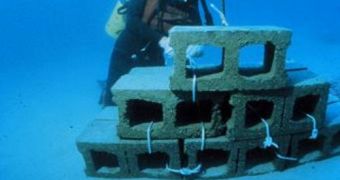One of the methods proposed by marine biologists in fighting the widespread, global loss of coral reefs is to construct artificial structures, of which these organisms could take hold. This has already been done with subway cars, and even war ships, which have been purposefully sunken at designated locations. But now experts have inadvertently created similar marine wildlife “hot spots” without even trying to do so, around the foundations of off-shore wind turbines. The bases of wave-energy devices also provide the necessary conditions for the establishment of coral reefs, ScienceDaily reports.
Moreover, it was demonstrated that alterations brought to these foundations could boost the incidence of a specific species at that particular location. Other than coral reefs, organisms such as blue mussels and barnacles also find these artificial structures to be an appropriate home, and squat them as soon as they become available. These announcements were made rather recently in a public dissertation, by Stockholm University Department of Zoology expert Dan Wilhelmsson. “Hard surfaces are often hard currency in the ocean, and these foundations can function as artificial reefs. Rock boulders are often placed around the structures to prevent erosion (scouring) around these, and this strengthens the reef function,” he revealed in his speech.
The European Union is a global leader in extending its wind farms along its shorelines, followed closely by countries such as Japan, the United States, India and China. Some of these nations are also investing time and money in wave-energy technology, which is a lot more complex than a wind turbine. However, all these lines of work require the various structures they entail to be anchored on the sea floor. At this point, many people are worried as to how marine creatures will react to the proposed mammoth wind farms that are to be constructed along shorelines. Experts are analyzing possible impacts to test for changes in noise, luminosity, hydrology, EM fields and other such factors.
“With wind and wave energy farms, it should be possible to create large areas with biologically productive reef structures, which would moreover be protected from bottom trawling. By carefully designing the foundations it would be possible to favor and protect important species or, conversely, to reduce the reef effects in order [to] minimize the impact on an area,” the expert said in his statement. He added that a careful balance needed to be maintained between promoting the aggregations of certain species in one spot, and ensuring that these species did not destroy and consumed everything else around.

 14 DAY TRIAL //
14 DAY TRIAL //